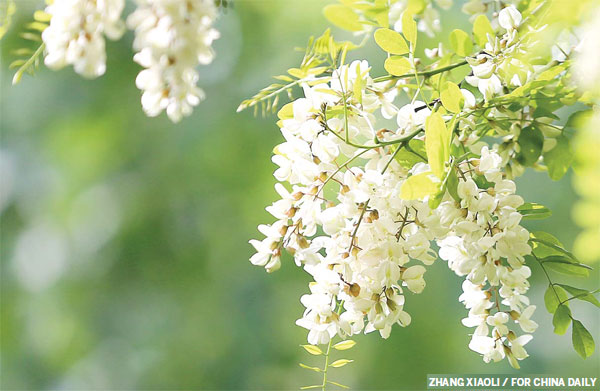Season of the locust eaters
Updated: 2016-04-15 08:54
By Pauline D Loh(China Daily Europe)
|
|||||||||
Editor's note: To understand China you have to sit down to eat. Food is the adhesive that holds the Chinese social fabric together. In the face of increasing globalization, food is also one of the last strong visages of community and culture.
In early May, the Chinese solar calendar marks "the beginning of summer". It is a day that indicates that the year is finally heating up, and that the fresh buds of spring are maturing into something else.
Often, that "something else" is more seasonal food.

Sometimes, what we eat is also drawn from what the country has experienced, whether it be feast or famine.
Our nanny hails from the very heart of China's Central Plains and is very good at making noodles, buns and dumplings. But she is even better at foraging.
Foraging? That sounds like a strange skill at a time when China is luxuriating in such decadent consumerism, and when widespread logistics supply fresh greens to markets even in the depth of winter.
However, memory runs deep in those fractions of the population who endured extensive hard times and cannot fathom what they see as wasteful spending around them these days. Our nanny is an example.

In early summer, she takes our dogs for their morning walks, and she always takes along a little cloth bag and a pair of scissors. When she comes home, the bag will be bulging with her foraged treasures.
And so I was introduced to tender steamed fritters of flowers from the locust tree, and to omelets made with the fresh green coins from elm trees. Our favorite is dumplings filled with minced shepherd's purse that she so carefully collects along the banks of the creek near our estate.
My nanny's foraging skills were honed at a time, long past, when food was scarce and everything was rationed. As a child, she was sent out to seek supplements for the dining table, and it was an important mission because it meant a big difference to a family of six hungry mouths.
This childhood frugality has stayed with her.
Not only does she bring home foraged edibles, but also she has turned our suburban backyard into a vegetable patch with summer harvests of cucumbers and gourds, and more tomatoes than we can possibly eat.
The locust tree, or yanghuai, bursts into bloom in late spring and early summer and is one of the most common trees in northern China. Its pendulous blooms are a little like cream-colored pea flowers, with little purses holding the stamens and pistils.
The buds are edible, no doubt, although they do not taste like an epicurean delight to me. My nanny dredges them in seasoned flour and steams them up. When my sister-in-law visits, she prefers to coat the flowers in cornmeal.
It is the same with the elm coins. These little round pods must be collected when they are still crisp and tender, with the seeds inside unformed. They are beaten with eggs and made into omelets. Sometimes they, too, are steamed.
What do they taste like? They taste like green seed pods.
To my nanny and sisters-in-law, though, they are both a reminder and a tribute to the hard times they have successfully survived, and so the taste is sweet.
Early summer to me means a collection of soups from our Cantonese kitchen.

The weather warms up faster in the south, and the humidity soon gets oppressive. This is when the wise southern Chinese housewife cools the family down with soups that clear the heat from their bodies.
Watercress is abundant and whole bunches go into quick soups flavored by a few pork ribs and a couple of seeded Chinese red dates. Sometimes, if a young member of the family is coughing or sniffling, a handful of sweet and bitter apricot kernels is added.
Food is medicine and a plethora of brews will see us through the humid heat of summer right through the bone chilling cold of winter.
To the Chinese, different foods possess different energy levels ranging from cooling to hot, and these are consumed according to the seasons.
Thus, fresh greens such as watercress, cucumbers, bitter melons, mustard greens and hairy gourds are dropped into soups that are quickly boiled to retain all their invigorating qualities.
Dried herbs may also be used, such as dehydrated Chinese yam, burdock, foxnuts and wolfberries.
It all comes down to balance, maintaining the yin and yang.
Eating lighter and fresher in summer balances the burden placed on the body by higher temperatures. Lighter soups of greens or melons are cooked with just a few slices of meat to balance nutrition and flavor. And finally, a few choice tonics or herbal ingredients make sure the dish is complete.
The Cantonese firmly believe that soup is everything, and they know their soups are the best.
In my years in Beijing, I saw the popularity of Cantonese soups grow, and the northerners seemed to enjoy imbibing as much as their southern comrades - with one difference.
In the south, we mainly drink the soup, whereas in the north, they consume everything, including the meat and vegetables that go into making the soup.
Now that's innate frugality rising to the fore.
paulined@chinadaily.com.cn
Two dishes you can try
Steamed locust flower
This recipe is for those fortunate enough to have these seasonal flowers in their backyards. Choose the young blossoms for their sweet honeyed fragrance.About a large salad bowl of locust flowers 1 cup of plain flour or cornmeal (polenta) Salt and pepper to taste Sesame oilRinse the locust flowers in salted water and dry thoroughly.Pick through and discard opened, wilted blossoms and hard stems.Dredge the damp flowers with the flour or cornmeal and season to taste.Place the flowers in a deep plate and steam over high heat for 10 minutes. Drizzle with sesame oil and serve.
Summer watercress soup
A refreshing soup to lift both spirits and palate in the growing heat of summer. 500g watercress 300g pork ribs (about four large pieces) 3-4 Chinese red dates, seededPrepare the watercress by pinching off the tender shoots and setting aside. Leave the long stems uncut and rinse both in slightly salted water to make sure no unwanted visitors cling to the vegetable.Boil a kettle of water and pour over the porkribs. This will get rid of any blood and scum on the surface.Place the long stems of the watercress in a pot and the scalded porkribs on top. Pour another kettle of water onto the ingredients and drop in the seeded Chinese dates.When the pot comes to a boil, lower the heat and simmer for half an hour to 45 minutes. You will be able to smell the soup as it mellows.Just when the soup is ready, bring it back to the boil and add the reserved watercress shoots. As soon as the tender leaves turn a darker green, switch off the heat, season and serve.This is a quick soup and we eat the green shoots and the pork ribs dipped in a little soya sauce.
Today's Top News
Passage to piraeus
In the hall of the great frescoes
World Bank joins AIIB on financing for joint projects
GM seeds to get oversight
Russia-China ties benefit both countries, peoples
China, UK showcase best books in London
Hello, China! Stephen Hawking debuts Weibo account
Manila set to restart revamp of airport in S China Sea
Hot Topics
Lunar probe , China growth forecasts, Emission rules get tougher, China seen through 'colored lens', International board,
Editor's Picks

|

|

|

|

|

|







